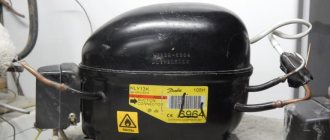Causes of leaks in the boiler
The factors influencing device failure are different.
If your water heater is leaking, it is extremely important to correctly determine the nature of the failure. In this case, it will be easier to repair the device.
Weak connection of the liner
Loose connections are the most common reason why a water heater tank leaks. Often the problem lies in loose connections of the exhaust or inlet pipes. To fix the damage, you need to tighten the joints with a wrench. In particularly difficult cases, replacement of the damaged pipeline is required. If a leak occurs immediately after installing the boiler, the problem may lie in a manufacturing defect in the connections. In this case, reinstallation is required.
If a leak is detected from under the cover covering the electrical part of the water heater, you must immediately disconnect the device from the network. If this is not done quickly, a short circuit may occur. Then the protective cover must be removed and the surfaces inspected to identify the location of the leak.
If the problem does not lie in damage to the threaded connections, you need to drain the water. Leaks often occur when the rubber gasket is severely worn. If the integrity of this element is damaged, it must be replaced.
Tank deformation
When the container is deformed, water does not always begin to drip from the bottom of the tank immediately when the device is filled. Often the problem appears within a few days after connecting the device. This is due to the fact that after cooling the volume of the liquid decreases, this leads to compression of the container. When water is drained, rarefaction processes begin in the tank. If the safety valve malfunctions, the tank becomes deformed. When the container is full, the internal pressure increases as the water heats up. This leads to a leak.
When installing, you must follow the instructions.
In addition, a problem may arise if a safety valve was not installed during installation. This device is placed on the main underwater pipe to prevent water hammer, which can provoke a sharp increase in the water level and pressure in the tank and its deformation.
Mechanical damage
If the heating tank is installed carelessly, it may become deformed. Often a similar problem occurs when it falls. Damage to the integrity of the boiler in this case is not the fault of the manufacturer, so such a breakdown cannot be repaired under warranty. The possibility of repairing the device in this case depends on the extent of the damage.
Safety valve malfunction
Damage to the safety valve is extremely dangerous, because may lead to damage to the integrity of the boiler tank. This element is needed in case the water in the container becomes too hot and the pressure inside rises to a critical level. The valve operates automatically and releases some of the liquid. This leads to a decrease in pressure.
To determine the functionality of the valve, first inspect the area where it is connected to the tank. If there are no drips in this part, check the tap. In the closed position, liquid should not leak. If water continues to drip, the faucet is not working and needs to be replaced.
Problems with the heating element
It is best to discuss what type of repair is needed with a specialist.
Problems with the heating element can also cause the tank to leak from below. A large amount of scale forms on this heating element, which leads to damage to the integrity of the sealing ring. To fix the problem, tightening the fasteners or replacing the heating element is required. In some cases, water begins to drip from under the bolts: only a specialist can decide what to do with such a problem. Soldering is not always possible, because... The walls of the tank are quite thin. The device often needs to be replaced.
Neglect of prevention
The internal elements of the heating device are constantly in contact with hard water containing many impurities. Deposits quickly accumulate, disrupting the functioning of internal elements. To prevent leaks from occurring, you need to install a filter, promptly change worn parts and carry out preventive cleaning of the internal cavity of the device from scale and dirt.
Incorrect installation
If installed incorrectly, a leak may appear from the bottom of the boiler. More often than not, water begins to drip from under the rubber ring. To fix the problem, you need to tighten the connection bolts better. In addition, leakage can occur when using poor-quality seals or defective fittings. In this case, the device must be reinstalled using the best consumables.
Main causes of leaks
If your water heater is leaking, the first thing you need to do immediately is disconnect the device from the electricity. Next, a thorough examination is carried out, during which you need to try to determine where exactly the water is flowing from.
And there may be several reasons for this. Here are just a few of them:
- the boiler has been operating for quite a long time and during this time it has never undergone maintenance;
- a magnesium anode was not installed in the water heater tank (or it had not been changed for a long time);
- the water heater tank is not grounded;
- the composition of the water that flows through the water heater tank is very poor;
- presence of a manufacturing defect.
Water heater device.
Regardless of the reasons why your water heater tank leaked, you need to remove it and make repairs or buy a new boiler.
This may also be the final stage in the operation of your water heater. The main cause of water heater failure may be a heating element (heating element) broken due to scale.
This problem occurs most often, so it is very important to periodically clean the tank and heating elements that make your boiler work
There are several reasons why water drips from the boiler:
- manufacturing defect;
- poor-quality installation of the device;
- the anode is destroyed;
- the heating element is faulty;
- the valve has deteriorated;
- the gasket is worn out;
- blockage
For repairs you will need:
- adjustable wrench (large);
- Screwdriver Set;
- tubular keys;
- a set of simple keys;
- drain hose;
- rags;
- pad;
- cutter.
- Shut off the water supply
- Wait several hours for the water in the boiler to cool down.
- Remove the heater.
- Conduct an external inspection. If he has not identified the cause of estrus, proceed to analysis.
- Remove the protective cover using a screwdriver. You'll have to use force.
- Drain the water.
- Check the inlet and outlet pipes. Touch the insulating gasket. If dry, proceed to the next steps.
- Check valve. If it is not damaged during installation, the search for the cause of the leak continues.
- If the spiral or blockage is to blame, you will have to open the thermos.
- Remove the wires after taking a photo of the connections.
- Unscrew the fastening elements of the heating element and thermostat.
- Inspect the heating element.
- Clean the inside of the tank from dirt.
If it is not clear why the water heater is leaking, its use is stopped and the device is sent in for repair.
Possible manufacturing defect. If there was an error during installation, you will have to correct the problem at your own expense.
If drips appear on the body of the device, you should not immediately proceed with dismantling; you must first carry out a preliminary visual inspection. This is a very important method that will help quickly identify the leaky area.
The correct inspection sequence should be as follows:
- Fill the water heater with water up to about. This should not be done forcibly, since leaks can appear only when the water heats up.
- Inspect the bottom of the water heater, especially the seams and seal of the heating element cover.
- Inspect the walls of the device. In these places, leakage occurs extremely rarely, only during long-term operation of the water heater.
- Inspect the top.
Reasons for leaking boilers from different companies
Most manufacturers pay attention to the quality of boilers, so leaks due to manufacturing defects are rare. More often than not, this problem occurs due to improper installation and operation. At the same time, the products of each brand are characterized by certain types of breakdowns.
"Termex"
Thermex boilers often leak from the bottom of the tank due to damage to the bulb covering the heating element. In this case, you need to unplug the device and remove the cover. Then the fistulas are sealed. Cold welding can be used. In addition, leakage often occurs due to the separation of the flange gasket, as well as damage to the fum tape that ensures the tightness of the connections. In this case, connection of all boiler elements is required.
"Ariston"
Finding the cause of the malfunction will not be difficult.
Devices for heating water are popular, so a lot is already known about their common breakdowns. Leaks in such devices often occur due to manufacturing defects, as well as due to improper transportation; as a result of a strong impact, the integrity of the welds is damaged. This causes water to start dripping from the bottom immediately after installation or within a few days.
In addition, a breakdown may occur due to the lack of a safety plastic valve or too high pressure in the water supply network. This leads to the divergence of the tank welds. The possibility of repair depends on the extent of the damage. To prevent the occurrence of such a defect, a gearbox should be installed when installing the device.
Other
Breakdowns of Baksi, Zanusi, Bosch, etc. boilers often occur. Most often, malfunction of devices occurs due to improper installation and hard water. The absence of a safety valve is another common reason for the rapid failure of the device. Water hammer leads to damage to the integrity of the tank. Factory defects in models from these manufacturers are rare.
How to fix a leaking water heater
When you have identified the cause of the leak and assessed your capabilities, you can begin repairing. To repair a boiler, you need to prepare a hose and a container for draining hot water, a screwdriver or screwdriver, a set of keys and a multimeter or indicator. Carefully study the design of the device if you have never encountered disassembling the device. The design of a water heater is not as simple as it seems at first glance.
Let's look at step-by-step instructions for eliminating boiler leaks if you need to replace the heating element.
Step – 1. Disconnect the device from the power supply and turn off the water supply valves.
Step – 2. Unscrew the pipes, connect the hose, open the valve and drain the water from the storage tank.
Step – 3. Remove from the wall and dismantle the old heating element.
Step – 4. Install a new heating element, assemble the structure and install it in place.
If the reason lies in a leak in the tank itself, the boiler cannot be repaired. The water heater is a monolithic structure similar to a thermos, and it will not be possible to dismantle the tank from it.
Is it possible to repair water heaters?
To repair standard damage, you will need some tools.
In some cases, you can restore the functionality of the water heater yourself. The following tools and materials will be required:
- keys;
- tubes;
- bucket;
- multimeter
You must immediately disconnect the device from the power supply and carefully inspect the tank to identify the location of the leak. Then drain the water from the boiler, remove all protective covers to gain access to the inside of the device. If the problem lies in the gasket or heating element, they are replaced.
If a violation of the integrity of the welds has been identified, you need to contact a professional. It is difficult to fix such a breakdown on your own. Parts are often coated with glass enamel, which quickly collapses during welding. Models in which the internal surface is made of stainless steel or plastic cannot be restored. In addition, it is impossible to repair a boiler if the water heater and tank are a single structure and cannot be disassembled without mechanical damage to the device.
Inspecting the water heater
If you find a leak in your boiler, then, first of all, you must disconnect the device from the electrical network.
Next, acting slowly, you can proceed directly to the inspection. When conducting an inspection, we must determine the location where the leak occurred.
Note! If the boiler is leaking from above, then there can only be one cause of the problem: a hole has formed in the tank. There are several reasons for the appearance of such holes, let’s get acquainted with them
There are several reasons for the appearance of this kind of holes, let’s get acquainted with them.
- We didn't bother to ground the water heater tank beforehand.
- A boiler was purchased with a good old manufacturing defect.
- The water supplied from the tap is of poor quality.
- We have been using the boiler for two or three years, and during this time we have not even thought about taking preventive measures.
- The tank is missing the required magnesium rod.
Regardless of the cause of the leak, the device must be removed in order to be repaired (or, alternatively, replaced with a new one). It is worth noting that if water seeps out from under the plastic cover, then the damage is definitely serious, and the water heater most likely cannot be repaired.
In another case, if the seal of the tank is broken, liquid flows out from under the plugs, flowing down the inlet and outlet hoses. This is also a sign that the broken heater will need to be replaced.
Note! The problem that unfortunate owners of water heaters most often encounter concerns heating elements - or, more simply, elements that directly heat the water. Heating elements break quite often, so they, as well as storage tanks, must be periodically descaled











